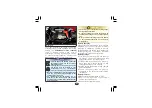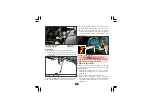
VALVE CLEARANCE
Excessive valve clearance will cause noise, and
little or no clearance will prevent the valve
from closing and cause valve damage and
power loss. Check valve clearance at the
specified intervals
(page 26)
.
2
1
4
3
(3) 'T' mark (4) Index mark
(1) Crankshaft hole cap (2) Timing hole cap
The adjustment must be made when the
î
Remove the crankshaft hole cap (1) and
timing hole cap (2) and tappet covers.
Adjustment
î
Rotate the flywheel anticlockwise until
the 'T' mark (3) on the flywheel coincides
with the index mark (4) on the left crankcase
cover. In this position the piston will either be
on the compression or exhaust stroke.
5
6
(5) Adjusting screw (6) Lock nut
piston is at Top dead center and both the inlet
and exhaust valves are closed.
This condition can be determined by moving
the rocker arms. If they are free, it is an
indication that the valves are closed and the
piston is in compression stroke.
If they are tight the valves are open, rotate the
O
flywheel 360 anticlockwise and re-align the 'T'
mark with the index mark.
(7) Feeler gauge
7
33
The checking or adjusting of valve clearance
should be performed while the engine is cold.
The clearance will change as the engine
temperature rises.
NOTE
















































